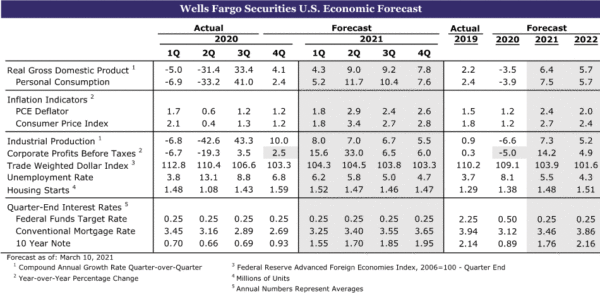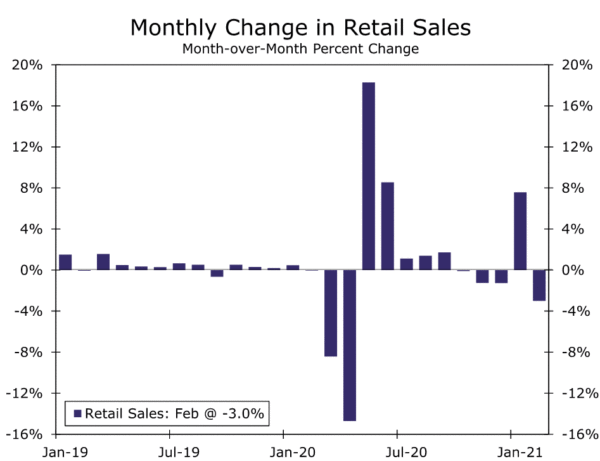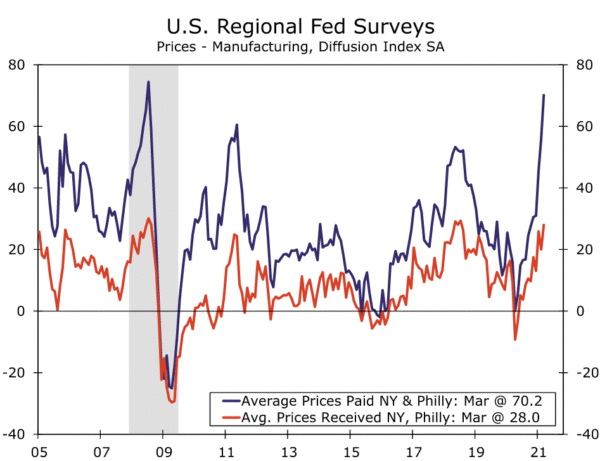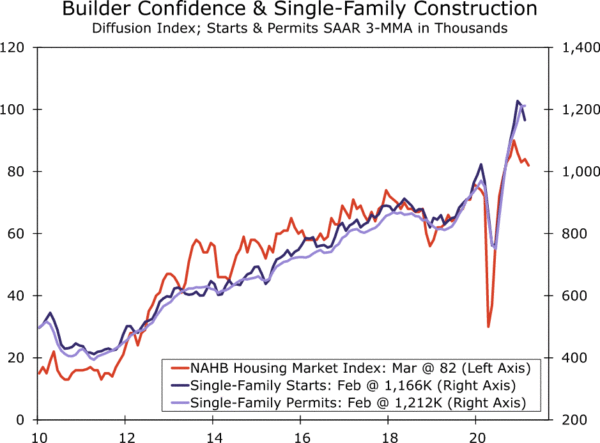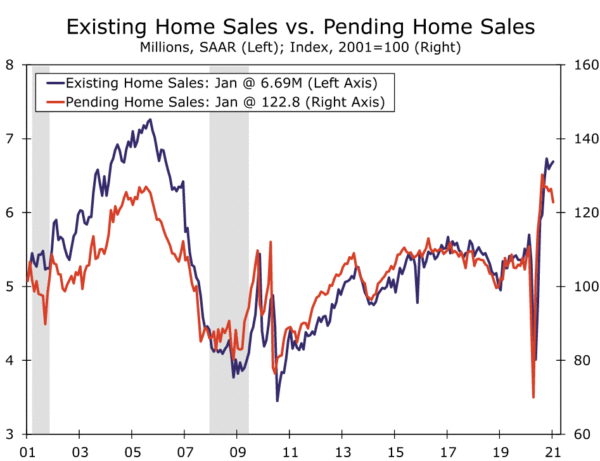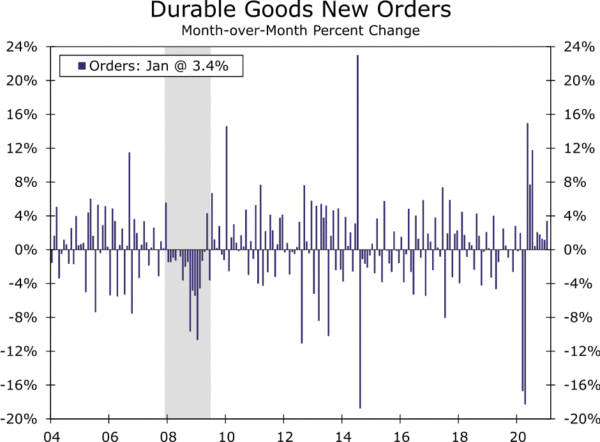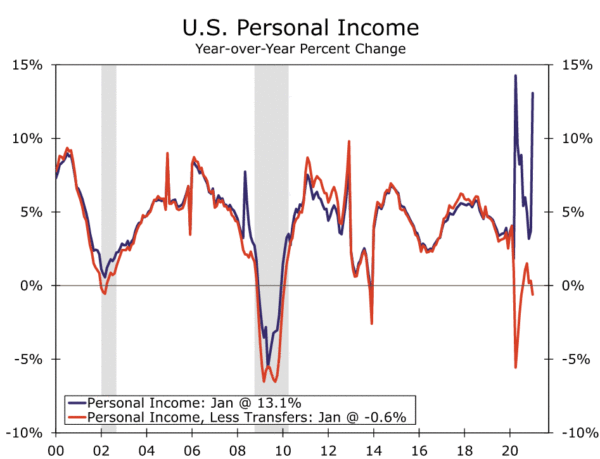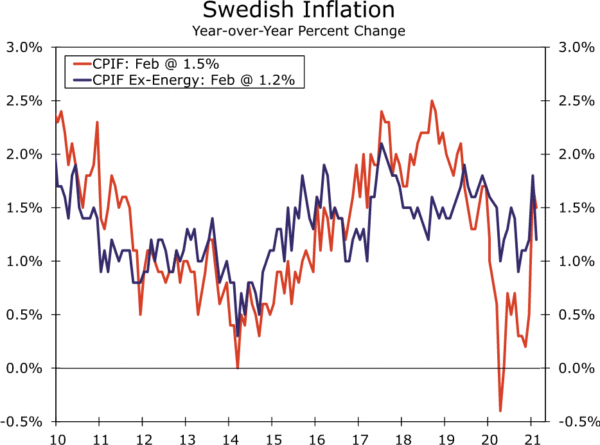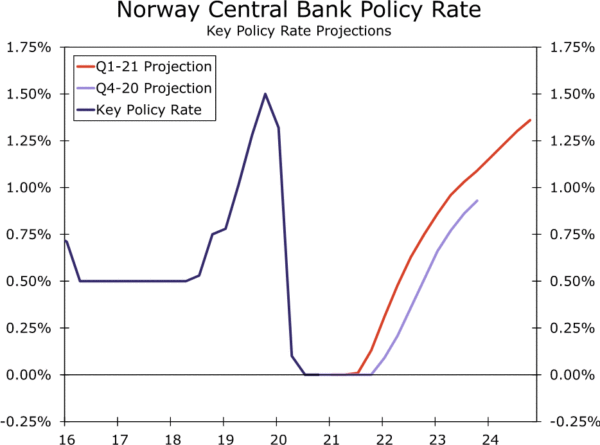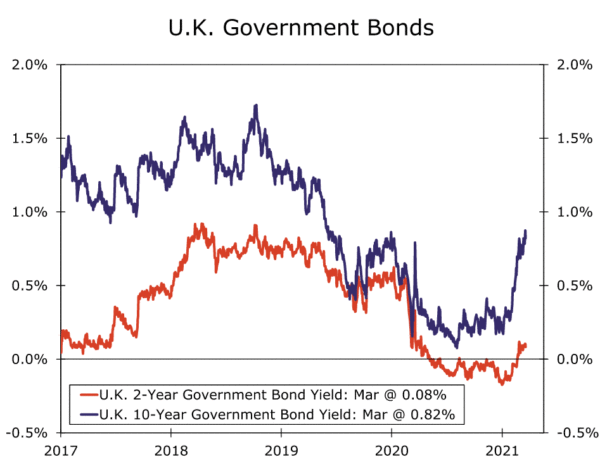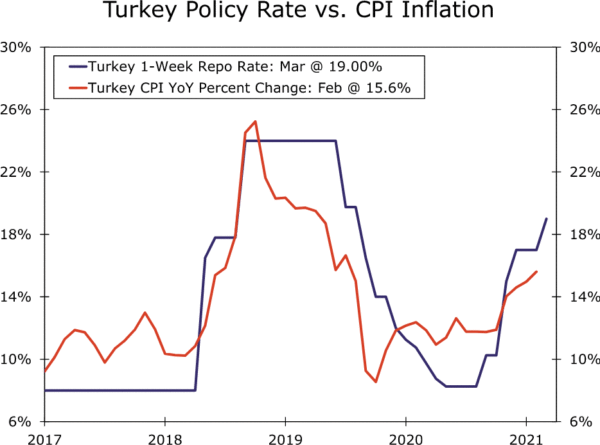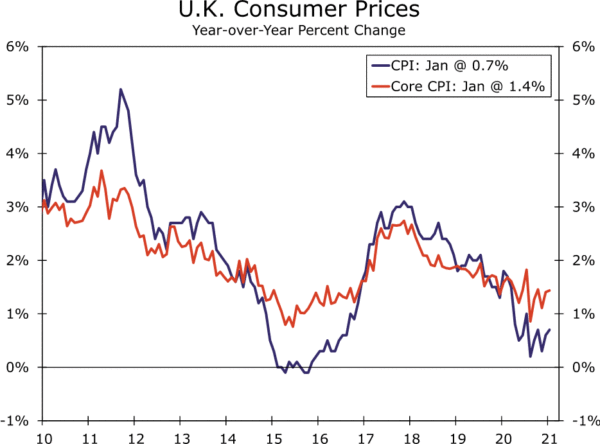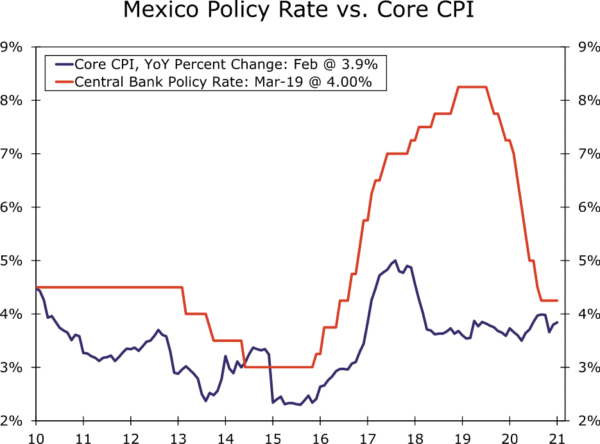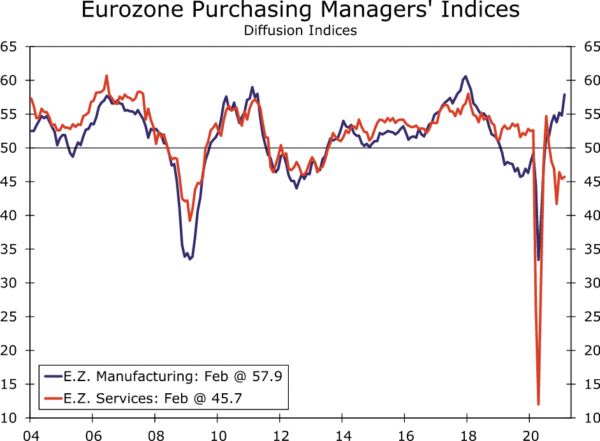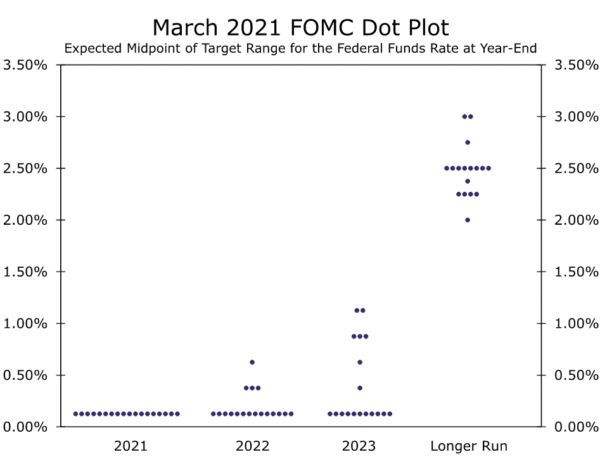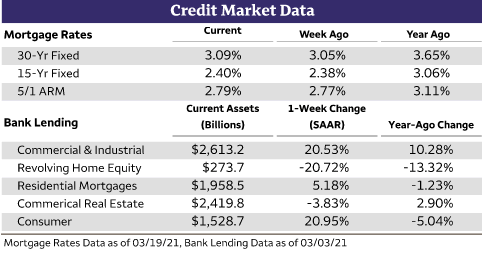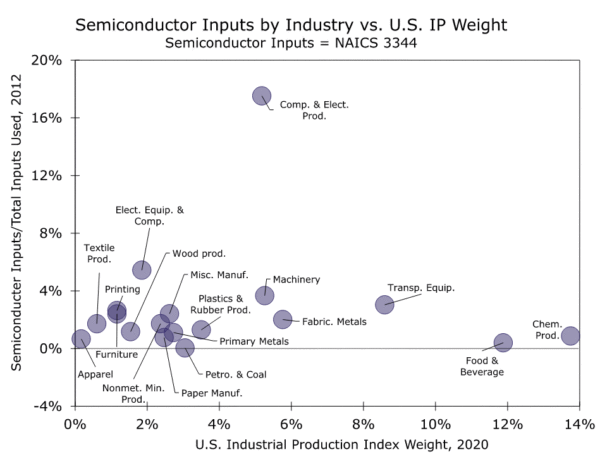U.S. Review
Still on Track for a Robust Recovery Even After Soft Data This Week
- The worse-than-expected outcomes for February retail sales, industrial production and housing starts were in part due to the severe winter weather that hit much of the country last month. However, other factors contributed to each sector’s decline, including payback for January’s stimulus-fueled spending spree in retail sales, semiconductor shortages holding back manufacturing production and rising costs crimping building activity.
- With the largest direct checks of the COVID crisis hitting household bank accounts this week, we do not believe retail sales are starting to roll over. Similarly, the supply challenges roiling the manufacturing sector are only a temporary setback. Demand for manufactured goods remains exceptionally strong, evidenced by the Philadelphia Fed manufacturing survey hitting nearly a 50-year high this week. And while housing activity may be cooling from its exceptionally strong pace late last year, low inventories should continue to support home-building even as mortgage rates move somewhat higher. In other words, we still expect a robust recovery in the coming months despite much of this week’s data coming in below expectations.
Global Review
Emerging Central Banks Surprise Market Participants
- It was a busy week for global economic data and central bank announcements. Swedish inflation unexpectedly slowed, with headline CPI and CPIF inflation easing in February and extending the period of below-target prices.
- Among the G10 central banks, the Norges Bank unanimously opted to hold the current policy rate at zero percent, but more notably, the central bank indicated that the policy rate will likely be raised in the latter half of 2021. Elsewhere, the Bank of England voted to keep its Bank Rate at 0.10% and maintained the pace of its government bond purchases.
- On the emerging market front, Brazil’s central bank surprised markets with a 75-bp rate hike to 2.75%, the first rate increase in roughly six years. The Central Bank of the Republic of Turkey delivered a large 200-bp rate increase, bringing the one-week repo auction rate to 19.00%, more than expected.
Interest Rate Watch
FOMC Appears to Be in No Rush to Tighten
- As expected, the FOMC made no policy changes at its meeting this week, but members did make sizable upward revisions to GDP and inflation forecasts for this year. While a few more officials see the fed funds rate rising in 2022 or 2023, the majority of the committee still expect rates to be on hold through 2023.
Topic of the Week
When the Chips Are Down: Macro Implications of Semiconductor Shortages
- The global shortage of semiconductors continues to intensify and is leading to industry disruptions. Semiconductors account for just about 2% of total inputs used in the U.S. manufacturing process, but we analyze if shortages could cause broader macro disruptions.
U.S. Review
Weather and Then Some
The rapid changes of the current economic cycle have meant that data hitting the wire are not always telling of where the economy is headed. That seems doubly true this week as the largest direct checks began to hit households’ bank accounts and February reads on activity were held down by harsh winter weather.
The 3.0% drop in February retail sales was more about where consumer spending has been rather than where it is going. February’s decline can be attributed partly to payback after an upward revision to what was already a monster gain in January (now +7.6%), fueled by the $600 checks from the December relief package. Bitterly cold winter weather through much of the country also kept some shoppers home, further holding down sales.
With checks more than twice the size of those that spurred sales in January on their way to households this week, retail sales are not starting to roll over, in our view. We look for sales to jump again in March and/or April. While there may be a month or so of payback after another spike, ultimately consumers remain flush with cash, which we believe will keep spending rising at a solid rate in coming months, even if services account for the bulk of that growth.
Similar to the decline in retail sales, we see February’s industrial production report as a temporary setback in what has been, and should continue to be, an impressive run in manufacturing. According to the Federal Reserve, the bulk of the 2.2% decline in industrial output last month can be traced to the severe winter weather. While the extreme temperatures led to a jump in utilities, mining declined 5.4% and manufacturing fell 3.1%. Weather wasn’t the only factor holding back factory output last month. Excluding weather effects, the Fed estimates manufacturing output would have fallen about half a percent. That’s due in no small part to the global shortage of semiconductors, which we discuss in our Topic of the Week, coming to a head.
While weather and major supply shortages held back factory production in February, demand remains solid and suggests the drop is only temporary. Nowhere this week did that seem to be clearer than the March Philadelphia Fed Business Outlook Survey, which shot up to 51.8, nearly a 50-year high. While the New York Fed’s Empire State survey did not match the stratospheric level of the Philly Fed survey, it also pointed to strengthening activity. Both reports showed no signs of bottlenecks easing up yet as capacity remains the factory sector’s biggest near-term challenge. Price pressures continue to rise as a result. Not only are input costs strengthening, but more manufacturers are passing those costs on, evidenced by the average of the two survey’s prices received components rising to the highest point since 2018 in March.
Source: Federal Reserve Bank of New York, Federal Reserve Bank of Philadelphia and Wells Fargo Securities
The return of winter weather also did a number on housing starts in February. Starts tumbled 10.3%, with the deep freeze that hit Texas apparent in the South’s 16% decline in single-family starts. That said, we believe February’s drop also reflects some more general cooling in the housing market after the exceptionally strong pace of recent months. Rising material costs and now mortgage rates are likely to contribute to a more moderate pace of growth in the months ahead. The NAHB/Wells Fargo Housing Market Index remains quite high, but slipped two points in March.
U.S. Outlook
Existing Home Sales/New Home Sales • Monday/Tuesday
The housing market continues to be white-hot, but there are some signs of a modest cool down on the horizon. Sales improved during January, with existing home sales advancing 0.6% and new home sales rising 4.3%. The robust pace of sales recently has been mostly owed to increased household space needs and low mortgage rates. While larger space requirements are still driving purchase demand, mortgage rates have begun to creep up alongside a climbing 10-year Treasury yield. Mortgage rates are still very low by historical standards, but rising financing costs together with low inventories and double-digit home price appreciation may be starting to damper buying conditions.
Pending home sales, which lead contract closings by one to two months, slipped 2.8% in January. What’s more, mortgage applications for purchase declined in February after steadily climbing for most of January. With both mortgage applications and pending home sales retreating, we expect home sales to pull back in coming months. The harsh winter weather seen in many parts of the country brings additional downside risk for both February and March. Even with some moderation, however, favorable demographics and rebounding job growth should help keep sales running at a fairly robust rate this year.
- Previous: 0.6%, 4.3%; Wells Fargo: -3.0%, -5.0%
- Consensus: -2.8%, -4.6% (Existing Sales, New Sales; Month-over-Month)
Durable Goods Orders • Wednesday
The factory sector is off to a strong start in 2021. During January, durable goods orders jumped 3.4%, more than three times the expected gain of 1.1%. Civilian aircraft lifted both orders and shipments as Boeing began long-delayed deliveries after addressing problems with its key 737-MAX. Nondefense capital goods shipments rose 3.2%, which means equipment spending should be supportive of Q1 GDP growth. What’s more, the recent strength extends beyond aircraft. Primary and fabricated metals, computers and related products as well as transportation equipment all posted notable gains in both orders and shipments. We expect durable goods orders rose 2.1% during February, with transportation again providing a boost to orders. Excluding transportation, we look for a 0.7% improvement. Overall, the recent strength in durable goods orders and shipments points to a strong year ahead for manufacturing and business fixed investment.
- Previous: 3.4%; Wells Fargo: 2.1%
- Consensus: 0.9% (Month-over-Month)
Personal Income and Spending • Friday
Personal income and spending both surged in January. Income shot up 10% as the stimulus checks provided by December’s COVID relief bill hit many households’ bank accounts. Wages and salaries also rose 0.7%; however, those gains were offset by declines in proprietors’ income & dividend income. Personal spending increased a robust 2.4%, which was a shade below consensus estimates but still one of the largest monthly gains since the economy first re-opened after last year’s lockdown.
January’s stimulus-induced, outsized gain in both income and spending means there will likely be some payback in February. We anticipate a 5.8% drop in income growth, which is not quite as sharp a decline as the consensus. The next round of fiscal relief is just getting under way and likely will not be evident in the data until March. Personal spending also likely back-tracked. Retail sales posted a surprise 3.0% decline during February, a drop that may have been partially owed to the harsh winter weather that occurred in many parts of the country. Overall, we expect personal spending to dip 1.0% in February, which is slightly below market expectations.
- Previous: 10.0%, 2.4%; Wells Fargo: -5.8%, -1.0%
- Consensus: -7.0%, -0.8% (Income, Spending; Month-over-Month)
International Review
Swedish Inflation Slows in February
Swedish inflation unexpectedly slowed in February, extending the period of below-target prices. Headline CPI inflation slipped to 1.4% year-over-year from 1.6% the previous month. Meanwhile, CPIF inflation—Consumer Price Index with a fixed interest rate—eased to 1.5% in February, down from 1.7% the prior month. Food prices decreased in several subgroups—particularly on meat and fish—offsetting price increases on clothes, fuel and electricity. Meanwhile, CPIF excluding energy fell to 1.2% year-over-year, down from 1.8% in January.
Also this week, the March 2021 survey on inflation expectations by Kantar Prospera, which is commissioned by the Riksbank, indicated Swedish money market participants, labor market parties and purchasing managers now expect higher annual inflation than previously seen in the December survey. The survey suggests CPIF inflation, which was 0.8% in December, should reach 1.3% in one year, 1.5% in two years and 1.8% in five years. Meanwhile, in a recent speech, Riksbank Deputy Governor Jansson said inflation is expected to rise gradually in the long run due to temporary effects, while he also said he is “happy” that inflation expectations are rising. He also noted that if inflation were to rise above the central bank’s 2% target, it would not be a big issue.
Global Central Banks Back in the Spotlight This Week
The Norges Bank unanimously decided to keep the current policy rate at zero percent, but more importantly, indicated that the policy rate will likely be raised in the latter half of 2021. The central bank did note that the economic recovery is being held back by higher infection rates and strict containment measures, which have created some uncertainty about the evolution of the pandemic and its economic impact going forward. However, the bank indicated its optimism results from information from health authorities indicated that a large portion of the adult population will likely receive the vaccination before the end of summer. Since its December monetary policy meeting, Norwegian economic activity has picked up, with higher household demand as the main driver of activity in the mainland economy. That said, the Norges Bank indicated in the December monetary policy report that economic activity is likely to approach a normal level earlier than expected and capacity utilization should be closer to normal by the end of this year.
The central bank’s revised policy rate path shows the first rate hike will likely occur in Q4-2021 followed by additional hikes in 2022 and implies a continued expansionary monetary policy over the longer term. Given these developments, we see risks to our current rate path forecast for the Norges Bank as skewed toward earlier rate hikes.
Source: Norges Bank and Wells Fargo Securities
The Bank of England (BoE) also met this week to announce policy. The BoE unanimously voted to maintain its Bank Rate at 0.10% and left the pace of its government bond purchases unchanged at £875 billion. Given that market participants widely expected the central bank to remain on hold, most of the focus in this week’s announcement was in the policymakers’ tone. Policymakers appear to be mostly more constructive on the economy, amid positive developments on the economic front over the past month and as the rate of COVID infections fell and the vaccination program picked up pace. The BoE did note, however, that there is a material degree of spare capacity at present and inflation remains below the central bank’s 2% inflation target and echoed that the outlook for the economy remains unusually uncertain. The central bank also reiterated that it does not intend to tighten its policy measures before there is evidence of significant progress in eliminating space capacity and achieving its 2% inflation target sustainably. Since its previous monetary policy meeting, global bond yields have risen, including U.K. yields, however, the central bank did not appear too concerned with the past increases, saying that financial conditions have been broadly unchanged since the February report.
On the emerging market front, central banks surprised market participants this week with larger-than-expected interest rate hikes. At its March monetary policy meeting, Brazil’s central bank (BCB) unanimously decided to raise its policy rate 75 bps to 2.75%, which marked the first rate increase in roughly six years and went against consensus estimates for a 50-bp hike. Policymakers stated that new fiscal stimulus measures in some developed countries and the speed of COVID vaccinations should promote a strong economic recovery over the year, and noted recent Brazilian economic indicators—particularly the Q4 GDP release—suggest continued economic recovery despite reduced emergency income transfers. Meanwhile, inflation projections rose to levels close to the central bank’s upper bound of the inflation target. In the accompanying statement, the BCB also indicated that unless there is a significant change in inflation forecasts or the balance of risks, it expects a similar policy adjustment, of the same magnitude, at its next monetary policy meeting on May 5. If acknowledged, the Selic rate will increase to 3.5% in May. Elsewhere, the Central Bank of the Republic of Turkey (CBRT) delivered a larger-than-expected 200-bp rate increase, bringing the one-week repo auction rate to 19.00% from 17.00%. The CBRT opted to implement front-loaded, strong additional monetary policy easing due mainly to inflationary risks. Following the central bank’s announcement, the lira surged over 2% against the U.S. dollar.
International Outlook
U.K. CPI • Wednesday
Inflation in the United Kingdom edged up in January to 0.7% year-over-year, while CPIH—which includes owner occupiers’ housing costs—rose 0.9%. The increase in prices was due in part to upward moves in furniture & household goods, restaurant & hotels and food & transport prices. As noted previously, the central bank highlighted that the CPI inflation rate remains below the central bank’s 2% target rate, largely reflecting the direct and indirect effects of the pandemic on the economy. However, the central bank expects inflation to pick up and return to around its 2% inflation target in the spring amid recent increases in energy prices.
Next week also includes the release of February retail sales. Following new lockdown restrictions, activity fell sharply early this year. January retail sales plunged 8.2% month-over-month, with sales 5.9% below year-ago levels. With respect to the retail sector, survey data suggest a soft February as stores cut jobs. Meanwhile, the Confederation of British Industry retailers’ survey indicated sales were up only slightly from January’s low level, but the survey’s gauge of interest in retail sales reached a new high. For the official February retail figures, the consensus forecast is for sales to rebound 2.1% month-over-month.
Previous: 0.7%; Wells Fargo: 0.8%; Consensus: 0.8% (Year-over-Year)
Banxico Policy Decision • Thursday
Next week, the Central Bank of Mexico (Banxico) is set to announce policy. Ahead of its policy rate decision, Central Bank Governor Diaz de Leon indicated that the recent U.S. stimulus package and rising yields have led to some adjustments across markets, although it is still unclear the effect it could have on inflation and growth for Mexico. Diaz de Leon also indicated that the central bank would assess the most recent developments and rising inflation at its next monetary policy meeting on Thursday. In February, headline inflation remained above the central bank’s target midpoint due in part to rising fuel prices, with prices increasing a more-than-expected 3.76%, while core inflation edged higher. At its latest meeting, Banxico voted unanimously to lower its overnight rate by 25 bps to 4.00%, which came as a bit of a surprise for market participants. Given the unanimous vote and the central bank’s more dovish language in the subsequent statement, we look for another 25-bp rate cut at its policy meeting next week to 3.75%, with the risks tilted toward a hold.
Previous: 4.00%; Wells Fargo: 3.75%
Eurozone PMIs • Wednesday
The Eurozone economy remained resilient into the end of 2020, but further softness followed by a slow recovery seems likely this year. The Eurozone economy fell 0.7% quarter-over-quarter in the Q4, although a smaller decline than initially expected. Heading into this year, another decline in Eurozone GDP appears to be in store for Q1-2020. Recent data have been mixed, as retail sales plunged by a more-than-expected 5.9% month-over-month in January, the largest decline since April 2020. Industrial output, however, rose by a larger-than-forecast 0.8% month-over-month in January.
Next week’s release of the March Eurozone PMI surveys should provide some insight into just how weak Q1 GDP might be. The services PMI, in particular, remains at levels consistent with a further contraction in the Eurozone economy in Q1. The Eurozone services PMI ticked to 45.7 in February, and in fact, has been below the breakeven 50 level for six months in a row. The consensus forecast is for the services PMI to edge to 46.0 in March, below the breakeven level. Manufacturing activity has held up better so far, with the February manufacturing PMI rising 57.9, more than expected.
Previous: 57.9, 45.7; Consensus: 57.9, 46.0 (Manufacturing, Services)
Interest Rate Watch
FOMC Appears to Be in No Rush to Tighten
As widely expected, the Federal Open Market Committee (FOMC) made no major changes to its policy stance at its meeting on March 17. Not only did the committee maintain its target range for the fed funds rate between 0.00% and 0.25%, but it also kept its monthly purchase rate of Treasury securities and mortgage-backed securities at $80 billion and $40 billion, respectively. The FOMC also pledged to keep rates on hold “until labor market conditions have reached levels consistent with the committee’s assessments of maximum employment and inflation has risen to 2 percent and is on track to moderately exceed 2 percent for some time.”
In that regard, the FOMC upgraded its outlook for the economy, at least in 2021, in its Summary of Economic Projections (SEP), which summarizes the committee’s economic forecasts. The median forecast among the 18 committee members for GDP growth in 2021 is now 6.5%, up significantly from the 4.2% rate that was forecast in the December SEP. The median forecast now sees the unemployment rate ending 2021 at 4.5%, which is down from 5.0% in December, and at 3.9% at year-end 2022.
Apparently, an unemployment rate at 3.9% appears to not meet the FOMC’s definition of “full employment,” as most committee members continue to believe that it would be appropriate to keep rates on hold through the end of next year. As shown in the so-called “dot plot,” only four of the 18 committee members think that it would be appropriate to hike rates next year (see graph). Seven members believe that some degree of monetary tightening would be appropriate by the end of 2023, but that still leaves 11 members who currently think that rates should remain on hold through Q4-2023. Indeed, our own forecast looks for the FOMC to refrain from hiking rates at least through the end of 2022, which is the end of our current forecast period.
In sum, the FOMC’s apparent desire to remain on hold for an extended period of time means that the short end of the yield curve will remain at essentially 0% for the foreseeable future. However, the long end of the yield curve, over which the Fed has less control, has risen considerably in recent weeks due to expectations of stronger economic growth and higher inflation. We turn to the long end of the curve, and its implications for long-term borrowing costs for businesses, in our Credit Market Insights section.
Credit Market Insights
How Are Businesses Handling Higher Yields?
The yield on the 10-year Treasury has risen rapidly in recent weeks and is up roughly 50 bps over the past month. The rise in yields reflects a brightening outlook, but higher Treasury yields can translate into higher borrowing costs for businesses. So far, however, issuance has remained fairly strong. Even after a record-setting 2020, new issuance is up 33% and 81% year-to-date for investment grade and high yield, respectively. The price investment grade companies pay to borrow has started to pick up, but not as much as the 10-year Treasury, and the spread between the two continues to fall from the spike last spring. This is less true in the high yield space, where spreads have widened a little over the past month, although they remain near their pre-pandemic level.
These flat to tightening spreads make sense in the face of the recent increase in Treasury yields, as investors are pricing in a better growth outlook rather than concerns about the corporate sector’s solvency. If yields continue to surge higher, however, this could bring renewed attention to the corporate sector’s elevated debt levels. Even if companies do not need to issue new debt, rolling over the existing stock could be expensive. Fortunately, many companies have termed out their debt over the past 12 months and a stronger economy should help companies strengthen their balance sheets in the coming quarters.
Topic of the Week
When the Chips Are Down: Macro Implications of Semiconductor Shortages
The global shortage of semiconductors continues to intensify. Manufacturers across industries point to depleted inventories, supply shortages and record-high lead times, while analysts have been quick to report recent production cutbacks at U.S. auto manufacturing plants and electronic manufacturers. The global nature of the semiconductor supply chain and varying public health improvements across countries is adding to logistics pressures. Despite constrained supply, demand for semiconductors will likely remain strong this year due to high order backlogs and continued demand for consumer and business goods. Given how integrated supply chains are today, should we be worried semiconductor shortages will cause broader macro disruptions?
Semiconductors represent just 2% of total inputs used in U.S. manufacturing, but the share varies widely by industry.1 In the following figure, we graph the share of semiconductor inputs used in manufacturing industries versus the size of the domestic industries to gauge the possible disruptions to U.S. manufacturing production.
Unsurprisingly, the computer & electronics manufacturing industry, which manufactures semiconductors, also utilizes them the most within their own industry, with semiconductors accounting for nearly a fifth of total inputs used. Since the industry also accounts for about 5% of total U.S. production, a prolonged production halt in the industry due to shortages could have adverse effects on computer manufacturing and total U.S. output. Furthermore, there is the potential for knock-on effects to weigh on other sectors. For example, computers & electronics account for 13% of autos & parts manufacturing inputs and 9% of electrical equipment & appliance manufacturing inputs. Together these industries represent another 7% of total U.S. production, which increases the potential hit to total manufacturing should computer & electronics manufacturing remain under sustained pressure.
Specific industry effects are already evident in auto manufacturing. Semiconductors represent just 1.3% of the auto & parts manufacturing industries total inputs used, but domestic car manufacturers have reported temporarily suspending production or cutting 2021 production targets due specifically to semiconductor and related product shortages. After all, it can take just one missing part to upend a product’s entire manufacturing process.
Finally, with nearly 40% of U.S. semiconductor inputs imported, this is a matter of global supply chains. The varying degree of improvement in the public health situation across countries and limited factories with semiconductor manufacturing capability are constraining capacity and weighing on output. Increased supply bottlenecks are amplified by global transportation difficulties, particularly congestion at trading ports, which further strains already tight supply chains.
If semiconductor shortages are long-lasting, this could dramatically hamper the productive capacity of the United States. Referring back to the figure above, just about every major manufacturing industry uses semiconductors as an input. Therefore, in a “worst case” scenario, production of certain products across most industries could be at risk until manufacturers get their hands on enough semiconductors. In actuality, while we suspect some products may be slower to hit shelves or dealers’ lots this year, supply should eventually adjust to meet demand and bottlenecks should ease. Shortages will likely continue to create headaches for computer, electrical and transportation manufacturers for some time, but the widespread effects on the macro U.S. economy should remain manageable.
But, that’s not to say there won’t be a lasting effect from the recent semiconductor crisis. President Biden signed an executive order in late February launching a review of key supply chains, including semiconductors. Furthermore, while industry leaders continue to seek more incentives for domestic production, the current supply squabble may cause manufacturers to consider shorter supply chains or reconsider just-in-time inventory models. Reform to key supply chains could eventually lead to decreased reliance on foreign suppliers—a transition that may be set to occur across the manufacturing sector more broadly as the pandemic subsides.
1 To gauge the integration of the semiconductor industry, we turn to the Bureau of Economic Analysis’ input-output tables. We are primarily interested in the Semiconductor & Other Electronic Component Manufacturing (NAICS code 3344) industry. The latest data available at this detailed industry level, however, are from 2012. In comparing the share of inputs, the broader Computer & Electronics Manufacturing (NAICS 334) industry, which includes semiconductors, represents in 2012 versus more recent data as of 2019, we are reasonably confident that the shares of semiconductor inputs we’ve arrived at based on the 2012 data are still indicative of current supply dynamics. If anything, the shares represent a lower-bound given technological progress over the past seven years, which has made semiconductors more prevalent.




